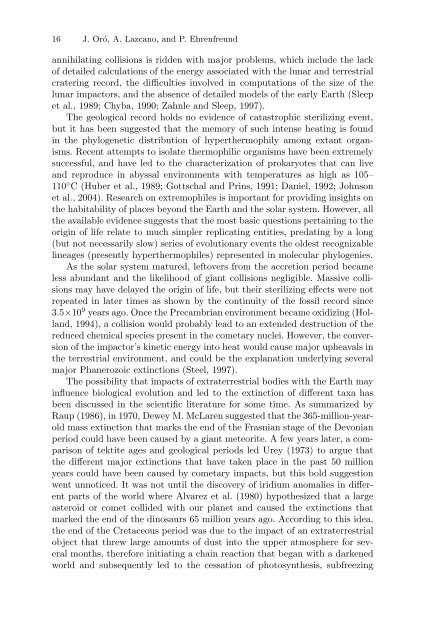Comets and the Origin and Evolution of Life
Comets and the Origin and Evolution of Life
Comets and the Origin and Evolution of Life
You also want an ePaper? Increase the reach of your titles
YUMPU automatically turns print PDFs into web optimized ePapers that Google loves.
16 J. Oró, A. Lazcano, <strong>and</strong> P. Ehrenfreund<br />
annihilating collisions is ridden with major problems, which include <strong>the</strong> lack<br />
<strong>of</strong> detailed calculations <strong>of</strong> <strong>the</strong> energy associated with <strong>the</strong> lunar <strong>and</strong> terrestrial<br />
cratering record, <strong>the</strong> difficulties involved in computations <strong>of</strong> <strong>the</strong> size <strong>of</strong> <strong>the</strong><br />
lunar impactors, <strong>and</strong> <strong>the</strong> absence <strong>of</strong> detailed models <strong>of</strong> <strong>the</strong> early Earth (Sleep<br />
et al., 1989; Chyba, 1990; Zahnle <strong>and</strong> Sleep, 1997).<br />
The geological record holds no evidence <strong>of</strong> catastrophic sterilizing event,<br />
but it has been suggested that <strong>the</strong> memory <strong>of</strong> such intense heating is found<br />
in <strong>the</strong> phylogenetic distribution <strong>of</strong> hyper<strong>the</strong>rmophily among extant organisms.<br />
Recent attempts to isolate <strong>the</strong>rmophilic organisms have been extremely<br />
successful, <strong>and</strong> have led to <strong>the</strong> characterization <strong>of</strong> prokaryotes that can live<br />
<strong>and</strong> reproduce in abyssal environments with temperatures as high as 105–<br />
110 ◦ C (Huber et al., 1989; Gottschal <strong>and</strong> Prins, 1991; Daniel, 1992; Johnson<br />
et al., 2004). Research on extremophiles is important for providing insights on<br />
<strong>the</strong> habitability <strong>of</strong> places beyond <strong>the</strong> Earth <strong>and</strong> <strong>the</strong> solar system. However, all<br />
<strong>the</strong> available evidence suggests that <strong>the</strong> most basic questions pertaining to <strong>the</strong><br />
origin <strong>of</strong> life relate to much simpler replicating entities, predating by a long<br />
(but not necessarily slow) series <strong>of</strong> evolutionary events <strong>the</strong> oldest recognizable<br />
lineages (presently hyper<strong>the</strong>rmophiles) represented in molecular phylogenies.<br />
As <strong>the</strong> solar system matured, leftovers from <strong>the</strong> accretion period became<br />
less abundant <strong>and</strong> <strong>the</strong> likelihood <strong>of</strong> giant collisions negligible. Massive collisions<br />
may have delayed <strong>the</strong> origin <strong>of</strong> life, but <strong>the</strong>ir sterilizing effects were not<br />
repeated in later times as shown by <strong>the</strong> continuity <strong>of</strong> <strong>the</strong> fossil record since<br />
3.5×10 9 years ago. Once <strong>the</strong> Precambrian environment became oxidizing (Holl<strong>and</strong>,<br />
1994), a collision would probably lead to an extended destruction <strong>of</strong> <strong>the</strong><br />
reduced chemical species present in <strong>the</strong> cometary nuclei. However, <strong>the</strong> conversion<br />
<strong>of</strong> <strong>the</strong> impactor’s kinetic energy into heat would cause major upheavals in<br />
<strong>the</strong> terrestrial environment, <strong>and</strong> could be <strong>the</strong> explanation underlying several<br />
major Phanerozoic extinctions (Steel, 1997).<br />
The possibility that impacts <strong>of</strong> extraterrestrial bodies with <strong>the</strong> Earth may<br />
influence biological evolution <strong>and</strong> led to <strong>the</strong> extinction <strong>of</strong> different taxa has<br />
been discussed in <strong>the</strong> scientific literature for some time. As summarized by<br />
Raup (1986), in 1970, Dewey M. McLaren suggested that <strong>the</strong> 365-million-yearold<br />
mass extinction that marks <strong>the</strong> end <strong>of</strong> <strong>the</strong> Frasnian stage <strong>of</strong> <strong>the</strong> Devonian<br />
period could have been caused by a giant meteorite. A few years later, a comparison<br />
<strong>of</strong> tektite ages <strong>and</strong> geological periods led Urey (1973) to argue that<br />
<strong>the</strong> different major extinctions that have taken place in <strong>the</strong> past 50 million<br />
years could have been caused by cometary impacts, but this bold suggestion<br />
went unnoticed. It was not until <strong>the</strong> discovery <strong>of</strong> iridium anomalies in different<br />
parts <strong>of</strong> <strong>the</strong> world where Alvarez et al. (1980) hypo<strong>the</strong>sized that a large<br />
asteroid or comet collided with our planet <strong>and</strong> caused <strong>the</strong> extinctions that<br />
marked <strong>the</strong> end <strong>of</strong> <strong>the</strong> dinosaurs 65 million years ago. According to this idea,<br />
<strong>the</strong> end <strong>of</strong> <strong>the</strong> Cretaceous period was due to <strong>the</strong> impact <strong>of</strong> an extraterrestrial<br />
object that threw large amounts <strong>of</strong> dust into <strong>the</strong> upper atmosphere for several<br />
months, <strong>the</strong>refore initiating a chain reaction that began with a darkened<br />
world <strong>and</strong> subsequently led to <strong>the</strong> cessation <strong>of</strong> photosyn<strong>the</strong>sis, subfreezing



